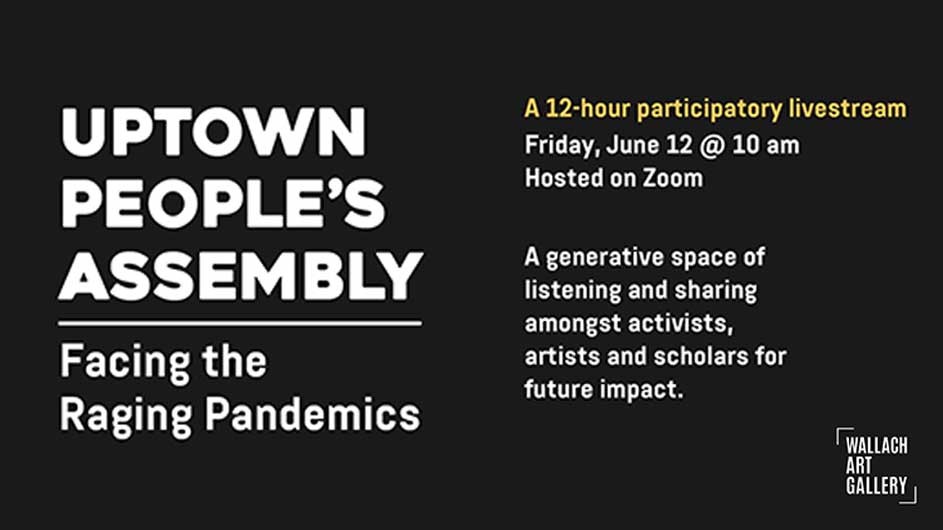The Wallach Art Gallery Convenes Uptown People’s Assembly: Facing the Raging Pandemics
A 12-hour, participatory livestream online event responds to COVID-19 and widespread civic unrest.

On June 12, 2020, the Wallach Art Gallery, of which I am the Director and Chief Curator, convened Uptown People’s Assembly: Facing the Raging Pandemics, a 12-hour, participatory livestream on Zoom. The event was organized in response to the double pandemics of COVID-19 and the recent racist killings of black people by police officers, which sparked widespread civic unrest. The livestream was designed to provide a space for generative listening and sharing at a time of crisis and change.
We posed the following question to a contingent of 12 co-conveners who all hailed from Upper Manhattan: What can we do collectively at this time of great grief, pain and anger about the pandemics raging in our midst? Each co-convener—Columbia centers and institutes, community organizations and individual artists—led one hour of participatory programming. Every session began with a presentation—a talk, a video, a reading—followed by an invitation to engage in a community conversation. Subjects ranged from "I can't breathe" and meditation exercises to spaces of care and the intersection of art and resistance with 20th-century African-American literature; the subject of breath wove in and out of most sessions.
Columbia co-conveners were Farah Jasmine Griffin, chair of the African American and African Diaspora Studies Department; María González Pendás and Arden Hegele, Society of Fellows/Heyman Center for the Humanities, and invited speaker, historian Amy Chazkel; Vivian Williams-Kurutz, Harlem Wellness Center, and Nohemy Aguirre, Columbia Community Wellness Center; J. Khadijah Abdurahman, Amiri Tulloch and Maurice Ivy Dowell, Black Siren Radio at the American Assembly and WKCR; and Vishakha Desai, Committee for Global Thought.
Community organization co-conveners were Pastor Joshua Brown, New Level Worship Center; Arden Sherman, Hunter East Harlem Gallery, with visual artist Juan Sanchez and filmmaker and producer Thomas Allen Harris; and Eric Pryor and Aubrey Lynch, Harlem School of the Arts, who introduced three young dancers. Harlem-based artists were Dianne Smith with singer-songwriter Hervé Coeur, filmmaker Cathleen Campbell, storyteller Daniel Carlton and DJ April Hunt.
I focus here on three sessions representative of the proceedings.
Early in the day, Dianne Smith presented George Floyd 7 minutes—a text and sound remix of Darnella Fraizer’s citizen video of Floyd’s death. The remix, emotionally charged, prompted a discussion about the layers of violence, both historical and current, that black communities resist and challenge every day. Smith and her interlocutor, Hervé Coeur, shared stories about being black in America against the background of recent events. Then Smith recounted why she made the video:
“I didn’t know what to do. I was filled with so much pain and anger, particularly because I didn’t just see George Floyd in that moment. I saw every black person—man, child, woman—at the mercy of the police," she said. "I was rubbing against the media and how they tell stories.”
Farah Jasmine Griffin began her session by reading a passage from Toni Morrison’s Song of Solomon in which Guitar, one of the characters, says, “The judge, the jury, the court are legally bound to ignore anything a Negro has to say,” referencing both deep-seated discrimination and state violence against blacks. Also poignant was Griffin’s response to the midwife Circe’s acerbic monologue, spoken from the ruins of the plantation mansion where she had been a servant:
“I often wonder if we, here in the United States, if we sit at the precipice of that kind of decline, if we are watching it all rot in ruin,” she said, and then invited attendees to share the artistic works that they were personally drawn to during this troubled time.
Vishakha Desai began her slideshow, “Art Making and Presenting in Turbulent Times,” with a brief transnational history of protest in visual art. She started with the resistance themes found in the Yuan Dynasty painter Wu Chen’s art, continuing through to Picasso’s Guernica and Jacob Lawrence’s Soldiers and Students.
The slideshow ended with recent artist protests and interventions at art museums. Desai deftly highlighted art’s synthesizing capacities with comments such as: “There is a power in art, that perhaps, gives us—a reflection moment, a moment of agitation, a moment of action and a moment of moving forward.” After, Desai led a discussion on the unique power of visual art to convey realities, message resistance and reignite memories, across cultures.
At the beginning of the day, Cathleen Campbell had presented her film, Langston Hughes' No Crystal Stair, and toward the end of the marathon event, Daniel Carlton read a piece of his own, inspired by Hughes’ words and life. Many such connections linked one session to the next, while opening up spaces for all participants to contribute their thoughts, erudition and experience.
Throughout the presentations were invitations to dance, sing and meditate. DJ April Hunt ended the evening with live music.